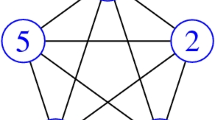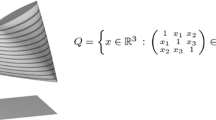Abstract
We prove that a general convex quadratic program (QP) can be reduced to the problem of finding the nearest point on a simplicial cone inO(n 3 +n logL) steps, wheren andL are, respectively, the dimension and the encoding length of QP. The proof is quite simple and uses duality and repeated perturbation. The implication, however, is nontrivial since the problem of finding the nearest point on a simplicial cone has been considered a simpler problem to solve in the practical sense due to its special structure. Also we show that, theoretically, this reduction implies that (i) if an algorithm solves QP in a polynomial number of elementary arithmetic operations that is independent of the encoding length of data in the objective function then it can be used to solve QP in strongly polynomial time, and (ii) ifL is bounded by a ‘first order’ exponential function ofn then (i) can be stated even in stronger terms: to solve QP in strongly polynomial time, it suffices to find an algorithm running in polynomial time that is independent of the encoding length of the quadratic term matrix or constraint matrix. Finally, based on these results, we propose a conjecture.
Similar content being viewed by others
References
P. Berman, N. Kovoor and P.M. Pardalos, Algorithms for the least distance problem, in:Complexity in Numerical Optimization (World Scientific, Singapore, 1993) 33–56.
W.S. Dorn, Duality in quadratic programming,Quarterly of Applied Mathematics 18 (1960) 155–162.
R.M. Freund, Dual gauge programs, with applications to quadratic program and the minimum-norm problem,Mathematical Programming 38 (1987) 47–67.
F. Granot and J. Skorin-Kapov, Towards a strongly polynomial algorithm for strictly convex quadratic programs: An extension of Tardos' algorithm,Mathematical Programming 46 (1990) 225–236.
L. Grotschel, M. Lovasz and A. Schrijver,Geometric Algorithms and Combinatorial Optimization (Springer-Verlag, Berlin, Heidelberg, 1988).
Sung-Pil Hong, About the strong polynomiality of some special classes of convex quadratic programming, PhD thesis, University of California at Berkeley, 1993.
W. Li, P.M. Pardalos and C.-G. Han, Gauss-Seidel method for least distance problems,Journal of Optimization Theory and its Applications 75(3) (1992) 487–500.
D.G. Luenberger,Linear and Nonlinear Programming (Addison-Wesley, Reading, MA, 1984).
K.G. Murty, On the linear complementarity problem,Operations Research Verfahren 31 (1978) 425–439.
K.G. Murty and Y. Fathi, A critical index algorithm for nearest point problems on simplicial cones,Mathematical Programming 23 (1982) 206–215.
C.R. Papadimitriou and K. Steiglitz,Combinatorial Optimization: Algorithms and Complexity (Prentice-Hall, Englewood Cliffs, New Jersey, 1982).
G. Strang,Linear Algebra and its Applications (Harcourt Brace Jovanovich, San Diego, CA, 1988).
E. Tardos, A strongly polynomial algorithm to solve combinatorial linear programs,Operations Research 34(2) (1986) 250–256.
P. Wolfe, Finding the nearest point in a polytope,Mathematical Programming 11 (1976) 128–149.
Author information
Authors and Affiliations
Additional information
corresponding author. The research was done when the author was at the Department of IE & OR, University of California at Berkeley, and partially supported by ONR grant N00014-91-j-1241.
Rights and permissions
About this article
Cite this article
Hong, SP., Verma, S. A note on the strong polynomiality of convex quadratic programming. Mathematical Programming 68, 131–139 (1995). https://doi.org/10.1007/BF01585760
Received:
Revised:
Issue Date:
DOI: https://doi.org/10.1007/BF01585760




